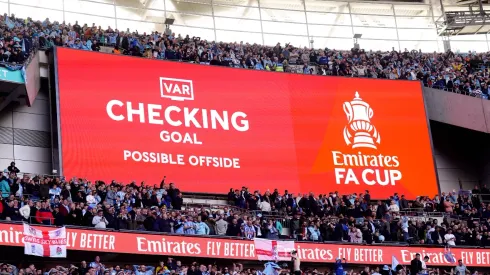Coventry’s eventual loss on penalties against Manchester United in the FA Cup semifinals was nearly one of the greatest stories in FA Cup history. A monumental comeback after trailing 3-0 in the second half led to Coventry scoring a stoppage-time winner in extra time. However, Haji Wright was marginally offside in the buildup to Victor Torp’s goal, and the Premier League side eventually won on penalties.
Immediately, the debate turned to the nature of the offside decision against Wright. Not only did the VAR review require extended time to make a pivotal decision. The length Wright was offside was no more than a few inches. Even with semi-automated offside decision-making coming to the Premier League in the 2024/25 season, this kind of decision will still plague soccer.
This is not to say semi-automated offside is bad. It is a welcome addition to the Premier League because it removes the monotonous and anticlimactic offside reviews VAR mandates. By all accounts, it follows the rule. Haji Wright’s position would be offside, there would just not be a delay. Semi-automated offside may even make these decisions more marginal. Tracking meaningful parts of players, whether that be heads, shoulders, knees or toes, will mean the slimmest of margins will be under the microscope.
The fact of the matter is that the offside rule forces these decisions. Changing the rule will help defend against these close calls, even when they have effectively no impact on the play. Was Haji Wright’s position in extra time always going to affect the play? Maybe, but it is not as if Wright was racing in behind the defense. Aaron Wan-Bissaka was backtracking, and he eventually caught up in the play.
Semi-automated offside decisions, or a change of the rule entire?
Sunday saw a great FA Cup moment ruined by a narrow decision. As stated, the call was the correct one. Wright was offside upon a VAR review, and the referees took the goal away. That is why allowing a cushion, or a margin for error for video assistant referees, can help make this process better.

The minuscule lines of often-pixelated decisions need to incorporate leeway. When a decision is this tight, it is a challenge to identify several variables. For one, when is the ball played? The freeze frames VAR uses depend on a split-second moment when an attacker plays a ball. That could be one frame when it looks like the ball is being hit, or it could be the frame after that in the VAR review when the ball starts moving. As seen with the Coventry City goal, those make a difference. In one frame, Wright was onside. In the next, he was offside.
Punishing Coventry for the determination that the ball was ‘played’ at a certain millisecond as opposed to another is incredibly harsh. It is one thing to get the call correct, but doing so at the expense of a scientific examination into when a ball moves and when a player runs is impossible.
The Wenger Rule for offside has been a hot topic following the FA Cup semifinals. The former Arsenal manager advocates for the full body of a player being offside rather than just a piece of him. In theory, this would produce more goals. However, the same issues would arise as attackers looking to run in behind the defense would time up their toes to be in line with defenders at the time a ball is played. Therefore, it is not the perfect solution.
Our Pick:Includes: Bundesliga, LaLiga, FA Cup, & More |
 |
Priority should go to the forwards
The purpose of the Wenger Rule is to give the benefit of the doubt to forwards. There is an argument there. Fans want to see more goals. Manchester City’s scoreless draw with Arsenal a few weeks back may have had millions of viewers in the United States, but they were all left disappointed by the lack of scoring. By contrast, the 3-3 game that required penalties had fans on the edge of their seats.
Modifying the offside rule to give attackers the edge may sting some fans. It will help more goals throughout soccer. Semi-automated offside decisions will continue to benefit the lackluster offside decisions that turn neutrals away.
PHOTOS: IMAGO.















